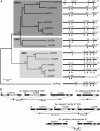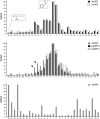Conservation of indole responsive odorant receptors in mosquitoes reveals an ancient olfactory trait
- PMID: 20956733
- PMCID: PMC3020388
- DOI: 10.1093/chemse/bjq105
Conservation of indole responsive odorant receptors in mosquitoes reveals an ancient olfactory trait
Abstract
Aedes aegypti and Anopheles gambiae are among the best-characterized mosquito species within the Culicinae and Anophelinae mosquito clades which diverged ∼150 million years ago. Despite this evolutionary distance, the olfactory systems of these mosquitoes exhibit similar morphological and physiological adaptations. Paradoxically, mosquito odorant receptors, which lie at the heart of chemosensory signal transduction pathways, belong to a large and highly divergent gene family. We have used 2 heterologous expression systems to investigate the functional characteristics of a highly conserved subset of Ors between Ae. aegypti and An. gambiae to investigate whether protein homology correlates with odorant-induced activation. We find that these receptors share similar odorant response profiles and that indole, a common and ecologically relevant olfactory cue, elicits strong responses from these homologous receptors. The identification of other highly conserved members of this Or clade from mosquito species of varying phylogenetic relatedness supports a model in which high sensitivity to indole represents an ancient ecological adaptation that has been preserved as a result of its life cycle importance. These results provide an understanding of how similarities and disparities among homologous OR proteins relate to olfactory function, which can lead to greater insights into the design of successful strategies for the control of mosquito-borne diseases.
Figures



Similar articles
-
Comparative genomics of odorant binding proteins in Anopheles gambiae, Aedes aegypti, and Culex quinquefasciatus.Genome Biol Evol. 2013;5(1):163-80. doi: 10.1093/gbe/evs131. Genome Biol Evol. 2013. PMID: 23292137 Free PMC article.
-
The Gr family of candidate gustatory and olfactory receptors in the yellow-fever mosquito Aedes aegypti.Chem Senses. 2008 Jan;33(1):79-93. doi: 10.1093/chemse/bjm067. Epub 2007 Oct 10. Chem Senses. 2008. PMID: 17928357
-
Molecular characterization of the Aedes aegypti odorant receptor gene family.Insect Mol Biol. 2007 Oct;16(5):525-37. doi: 10.1111/j.1365-2583.2007.00748.x. Epub 2007 Jul 17. Insect Mol Biol. 2007. PMID: 17635615 Free PMC article.
-
Molecular and functional characterization of the odorant receptor2 (OR2) in the tiger mosquito Aedes albopictus.PLoS One. 2012;7(5):e36538. doi: 10.1371/journal.pone.0036538. Epub 2012 May 14. PLoS One. 2012. PMID: 22606270 Free PMC article.
-
Identification of a chemosensory receptor from the yellow fever mosquito, Aedes aegypti, that is highly conserved and expressed in olfactory and gustatory organs.Chem Senses. 2004 Jun;29(5):403-10. doi: 10.1093/chemse/bjh041. Chem Senses. 2004. PMID: 15201207
Cited by
-
The co-expression pattern of odorant binding proteins and olfactory receptors identify distinct trichoid sensilla on the antenna of the malaria mosquito Anopheles gambiae.PLoS One. 2013 Jul 5;8(7):e69412. doi: 10.1371/journal.pone.0069412. Print 2013. PLoS One. 2013. PMID: 23861970 Free PMC article.
-
Insect olfaction from model systems to disease control.Proc Natl Acad Sci U S A. 2011 Aug 9;108(32):12987-95. doi: 10.1073/pnas.1103472108. Epub 2011 Jul 11. Proc Natl Acad Sci U S A. 2011. PMID: 21746926 Free PMC article.
-
Antennal transcriptome profiles of anopheline mosquitoes reveal human host olfactory specialization in Anopheles gambiae.BMC Genomics. 2013 Nov 1;14:749. doi: 10.1186/1471-2164-14-749. BMC Genomics. 2013. PMID: 24182346 Free PMC article.
-
siRNA-Mediated Silencing of doublesex during Female Development of the Dengue Vector Mosquito Aedes aegypti.PLoS Negl Trop Dis. 2015 Nov 6;9(11):e0004213. doi: 10.1371/journal.pntd.0004213. eCollection 2015 Nov. PLoS Negl Trop Dis. 2015. PMID: 26544686 Free PMC article.
-
Disruption of Aedes aegypti olfactory system development through chitosan/siRNA nanoparticle targeting of semaphorin-1a.PLoS Negl Trop Dis. 2013 May 16;7(5):e2215. doi: 10.1371/journal.pntd.0002215. Print 2013. PLoS Negl Trop Dis. 2013. PMID: 23696908 Free PMC article.
References
-
- Bentley MD, Day JF. Chemical ecology and behavioral aspects of mosquito oviposition. Annu Rev Entomol. 1989;34:401–421. - PubMed
-
- Bentley MD, McDaniel IN, Yatagai M, Lee H, Maynard R. p-Cresol: an oviposition attractant of Aedes triseriatus. Environ Entomol. 1979;8:206–209.
-
- Besansky NJ, Fahey GT. Utility of the white gene in estimating phylogenetic relationships among mosquitoes (Diptera: Culicidae) Mol Biol Evol. 1997;14:442–454. - PubMed
Publication types
MeSH terms
Substances
Grants and funding
LinkOut - more resources
Full Text Sources
Other Literature Sources

